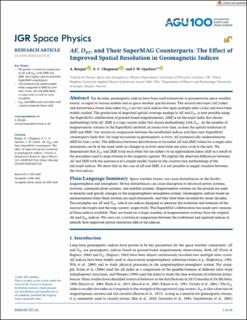| dc.contributor.author | Bergin, A. | |
| dc.contributor.author | Chapman, S.C. | |
| dc.contributor.author | Gjerløv, Jesper | |
| dc.date.accessioned | 2021-08-03T12:49:37Z | |
| dc.date.available | 2021-08-03T12:49:37Z | |
| dc.date.created | 2021-03-02T21:53:06Z | |
| dc.date.issued | 2020 | |
| dc.identifier.issn | 2169-9380 | |
| dc.identifier.uri | https://hdl.handle.net/11250/2766046 | |
| dc.description.abstract | For decades, geomagnetic indices have been used extensively to parameterize space weather events, as input to various models and as space weather specifications. The auroral electrojet (AE) index and disturbance storm time index (DST) are two such indices that span multiple solar cycles and have been widely studied. The production of improved spatial coverage analogs to AE and DST is now possible using the SuperMAG collaboration of ground-based magnetometers. SME is an electrojet index that shares methodology with AE. SMR is a ring current index that shares methodology with DST. As the number of magnetometer stations in the SuperMAG network increases over time, so does the spatial resolution of SME and SMR. Our statistical comparison between the established indices and their new SuperMAG counterparts finds that, for large excursions in geomagnetic activity, AE systematically underestimates SME for later cycles. The difference between distributions of recorded AE and SME values for a single solar maximum can be of the same order as changes in activity seen from one solar cycle to the next. We demonstrate that DST and SMR track each other but are subject to an approximate linear shift as a result of the procedure used to map stations to the magnetic equator. We explain the observed differences between AE and SME with the assistance of a simple model, based on the construction methodology of the electrojet indices. We show that in the case of AE and SME, it is not possible to simply translate between the two indices. | en_US |
| dc.language.iso | eng | en_US |
| dc.publisher | AGU | en_US |
| dc.rights | Navngivelse 4.0 Internasjonal | * |
| dc.rights.uri | http://creativecommons.org/licenses/by/4.0/deed.no | * |
| dc.title | AE, DST, and Their SuperMAG Counterparts: The Effect of Improved Spatial Resolution in Geomagnetic Indices | en_US |
| dc.type | Journal article | en_US |
| dc.type | Peer reviewed | en_US |
| dc.description.version | publishedVersion | en_US |
| dc.rights.holder | Copyright 2020 The Authors | en_US |
| dc.source.articlenumber | e2020JA027828 | en_US |
| cristin.ispublished | true | |
| cristin.fulltext | original | |
| cristin.qualitycode | 2 | |
| dc.identifier.doi | 10.1029/2020JA027828 | |
| dc.identifier.cristin | 1895101 | |
| dc.source.journal | Journal of Geophysical Research (JGR): Space Physics | en_US |
| dc.identifier.citation | Journal of Geophysical Research (JGR): Space Physics. 2020, 125 (5), e2020JA027828. | en_US |
| dc.source.volume | 125 | en_US |
| dc.source.issue | 5 | en_US |

